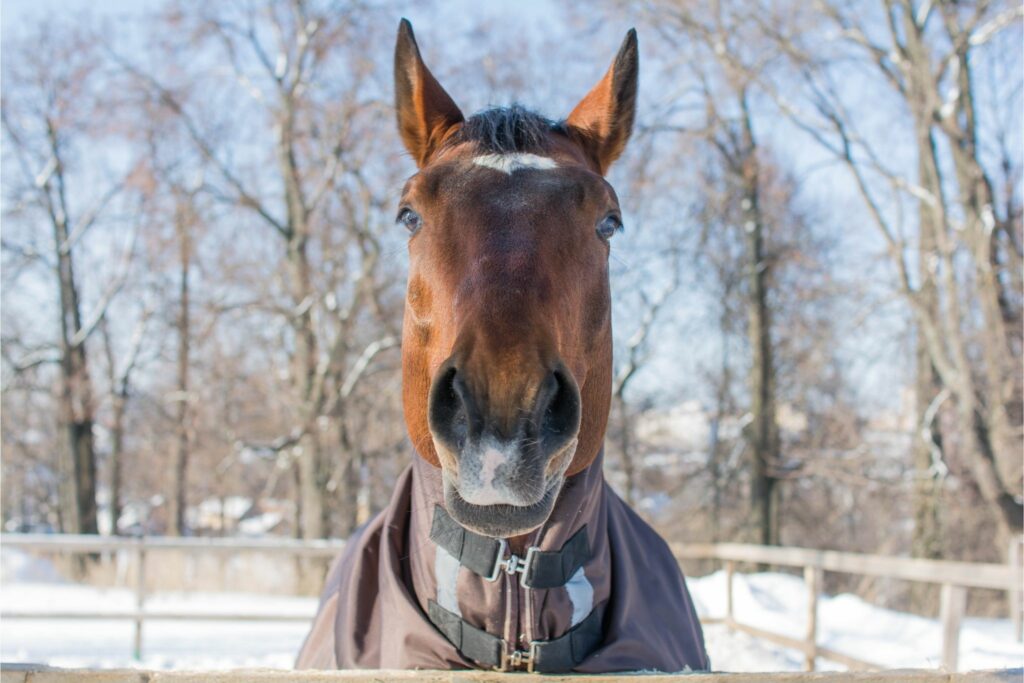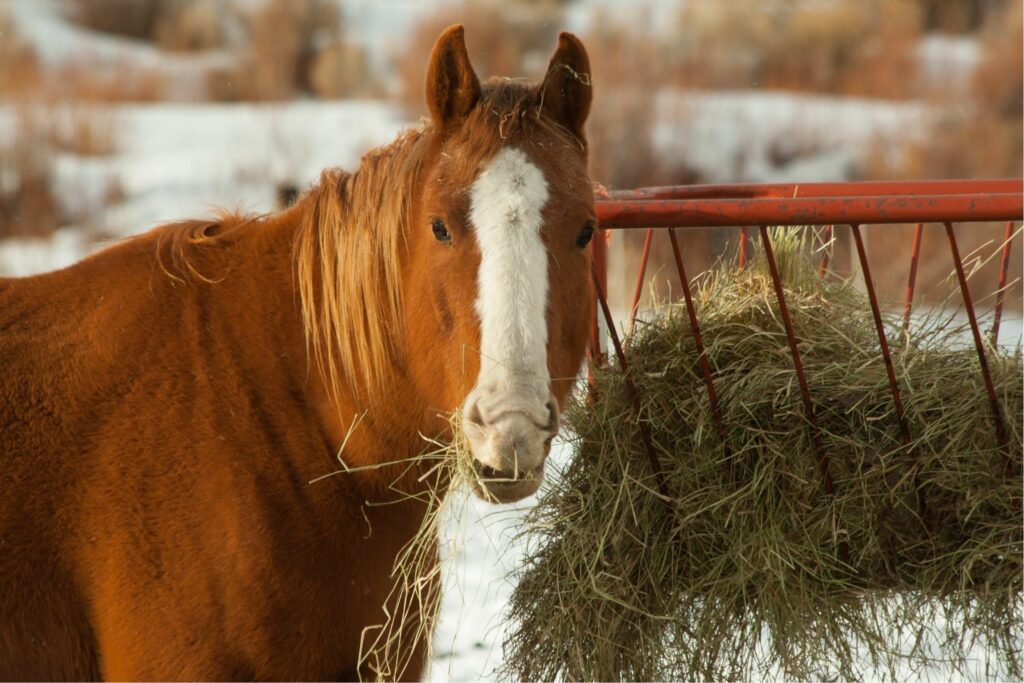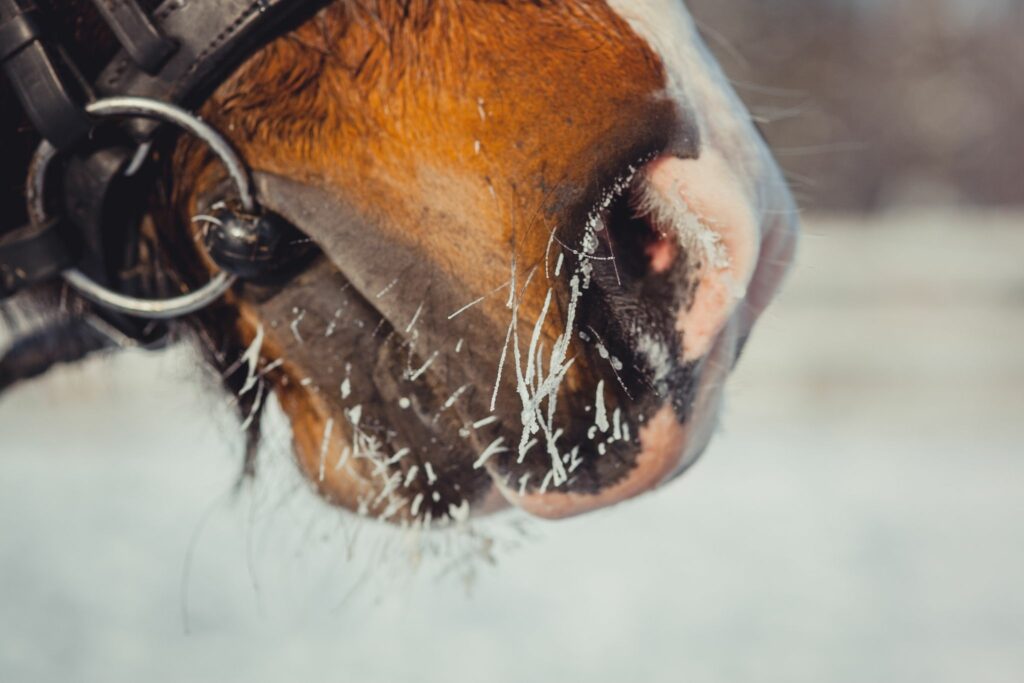Horse News
Member
Extra Challenges and Seasonal Strategies
Rain, sleet, snow, mud, and ice can be a MESS! It’s not easy taking care of animals outside in the cold, especially if you live somewhere with harsh winters. Some horses do well on their own with a little extra hair, food, and shelter. In contrast, others will need heavy blankets and lots of attention—it can vary not only from horse to horse but also season to season.
If you have never had to care for horses before in the winter, the prospect might sound intimidating. Just as we want to feel warm and well-fed, so do our horses. Using an empathetic approach plus a few simple management tricks will help ensure you don’t spend the winter chasing problems. This article will break down horse care essentials related to shelter, nutrition, and riding.
Winter Conditions – Shelter
Providing adequate shelter isn’t just about putting a roof over your horse’s head. For those of us who winter further away from the equator, wind, snow, rain, flooding, mud management, and the number of horses that a shelter can realistically house are all important considerations for the winter months. These factors are essential for both your enjoyment and your horse’s comfort.
How might shelter needs differ from winter to summer?
In the wintertime, there are more volatile weather patterns to consider along with drastic temperature swings and windchill factors.
Life is a little easier for horses in the summer as their primary concerns shrink to finding shade and avoiding biting insects.
While adequate shelter is important year-round, certain considerations are even more critical during colder months. Ensure your shelter has good ventilation and is faced away from the typical wind pattern. Horses can develop respiratory issues when they are stalled in a poorly ventilated area.
A lack of proper air flow is only exacerbated in winter months when outside-facing doors are often kept closed.
Do you need to blanket a horse in the winter?
Many horses will do just fine in the winter without a blanket, but some situations make them more necessary than others.
Conditions that may necessitate additional insulation include:
- Elderly horses
- Young horses
- Horses with medical problems
- Hard keepers
- Body clipped horses
- Horses new to the environment
- If you’re riding frequently, you might opt to blanket in order to help keep your horse clean and dry.

Photo Cred: Canva
Can horses stay outside in the winter?
As long as horses have adequate forage, shelter, and a pal or two, many horses can live outside 24/7 through the winter without much trouble. Horses that live outside still need regular hoof care, checks for injuries and body condition, and occasional grooming.
Regular grooming helps to disperse natural oils in the coat that repel water and insulate the horse from the elements.
How cold is too cold for horses to be outside?
This answer might surprise you, but horses can live outside even when it is really cold. According to the University of Minnesota, well-prepared horses can live outside in temps as low as -40℉!
The phrase “well-prepared” is an important part of that sentence—most horses won’t be able to tolerate temps quite that low without some extra help. That could include additional shelter, a temperature-appropriate blanket, and extra forage.
Most horses will be able to tolerate chilly temps down into the teens without too much prep needed.
Winter Conditions – Nutrition
If you have ever fed a hard keeper, you know how frustrating it can be to keep weight on once chilly temps settle in. Horses need extra calories to stay warm in the winter.
While access to clean drinking water is a requirement year-round, it can be extra challenging in below-freezing temps. Install water heaters or utilize heated buckets (safely!) to keep water thawed out.
Do you need to feed a horse differently in the winter?
This can be a tricky question! A horse that is kept in a heated barn can likely be fed similarly year-round. Horses that live outside will need extra forage during colder temperatures.
The process of digesting hay actually generates heat, so feeding an extra flake or two during extra cold temperatures is an effective way to keep them warm.
In general, you should avoid making any sudden, major changes to your horse’s die—changes should always be gradual. Throwing them an extra flake of the hay they’re already eating increases caloric intake without much additional risk.
You may opt to add some loose salt to your horse’s diet in cold weather to encourage drinking.

Photo Cred: Canva
How often should you feed a horse in the winter?
Ideally, horses would have unlimited hay or forage in front of them 24/7/365 so that they can self regulate both temperature and hunger. For many of us, that is just not possible.
Instead, feeding 2-3 times per day seems to work better with human schedules.
If you normally feed at 7 am and 7 pm, you may opt to add a lunch snack in the middle of the day. During a cold snap, a midnight snack can help keep outside horses warm during the coldest hours of the night.
How do you get a horse to drink enough water in the winter?
Staying hydrated is important year-round! Surprisingly, dehydration can be a major issue for horses during the winter months. Adding a few tablespoons of loose salt or electrolyte mix to your horse’s daily supplements can help encourage them to drink.
If you have access to safe wall outlets, heated or insulated water buckets or tank heaters are a life-saver for keeping troughs and buckets free from ice and at a temperature your horse will want to drink from.

Click to see heated buckets at Amazon

Winter Conditions – Riding
Riding in the winter doesn’t have to be uncomfortable for you or your horse. Simply take a few extra steps, and you’ll be well on your way to enjoying a crisp winter day with your horse.
How is riding a horse in the winter different from summer?
Expect your riding routine to take a little longer on either end of your ride. Many riders like to incorporate heat lamps in the grooming bays and use bit warmers before bridling to keep them comfortable.
I always keep a quarter sheet nearby for warm-ups and cool-downs.

Click to see quarter sheets at Amazon

How do you cool off a hot horse in the winter?
Body clipping a horse can be really helpful for horses remaining in full work over the winter. Clipping removes excess hair, allowing the horse to cool down (and dry off) faster, especially if they tend to get really sweaty. However, body clipped horses will need to be blanketed if they go outside as they won’t have the hair they need to keep warm.
Allow yourself extra time for hand walking or walking on a loose rein after a ride.
Utilize fleece or wool full-body coolers to help expedite the cool-down process. You should never put a horse away or put a blanket on a horse that hasn’t cooled down yet as it could cause skin problems and blanket mold. YUCK.

Click to see fleece horse coolers at Amazon

Do horses need a half sheet to ride outside in the winter?
Using a thick fleece or wool quarter sheet for both your warm-up and cool down is very helpful whether you ride indoors or out! The extra warmth from your ride can be nice for you, too.
If your horse is body clipped I would highly recommend using a quarter sheet out on a hack.
Like any new item, make sure your horse is comfortable with it on the ground before throwing your leg over. Some horses might not like the movement behind the rider and could spook if they’re new to a quarter sheet.
How do you care for a horse’s feet in the winter?
A quality hoof oil, balanced nutrition, regularly cleaned living areas, adequate movement, and a knowledgeable farrier all contribute to keeping your horse’s feet strong and healthy through the winter months.
I like to keep an extra rag in my grooming tote to wipe mud and moisture off of my horse’s feet.
Leaving mud caked on the hooves can cause the natural moisture barrier in the hoof to dry out, causing hoof cracking. Applying a hoof oil can help repel mud and seal much-needed moisture in the hoof.

Photo Cred: Canva
Frequently Asked Questions
Q: What is the best horse winter blanket?
The best blanket is the one that fits your horse and the conditions they’re in! Many people swear by a certain brand, weight, or cut for certain horses.
In general, look for a horse blanket with either ballistic nylon or at least an 800 Denier fabric, a waterproof coating, and a good fit. If you constantly have to readjust your blanket, it may be the wrong size or cut.
Q: What are signs that a horse is cold?
Similar to people, horses will start shivering when they are cold. Horses might turn their tail to the wind and clamp it down tightly against their bodies. Outdoor horses might huddle close to herdmates or near a wall or other wind-break.
If your horse regularly looks cold, it might be a good idea to get them a blanket or move them to an area that is more protected from the elements.
Q: How do you warm up a cold horse?
Movement and munchies! Horses produce body heat when they eat high-quality forage. Just like people, they also can warm up with movement. If you aren’t able to increase your horse’s normal feed, consider hand walking or light lunging.
I like having fleece coolers or stable blankets on-hand in case I have a chilly horse that needs to warm up.
You might also consider supplementing their diet with a hot mash. Shredded beet pulp or alfalfa pellets make for a great winter snack.
CAREFUL: Soak any dehydrated feedstuffs in hot water for at least 5-15 minutes before feeding—these products could cause impaction colic if fed dry.
Parting Thoughts
Caring for horses in the winter is not easy. Many equestrians dread the winter because of the shortened daylight, freezing cold, and inevitable mud. By preparing early, using the tools available to you, and being extra observant of your horse’s body condition, you and your horse can make the most of the season.
P.S. Enjoy this article? Trot on over to:
- 5 Best Winter Horse Riding Jackets
- Chill Out: Roeckl Winter Gloves Review
- Ariat Telluride Boots Review
- Ariat Heritage Lacer II Boot Review
- 9 Best boots for western horseback riding
Sources
Pennsylvania extension: https://extension.psu.edu/winter-care-for-your-horse
Minnesota extension: https://extension.umn.edu/horse-car...l-temperature-affects-nutritional-needs-51460
Bucket color study: https://ajvs.cl/index.php/ajvs/article/view/22
The post Winter Horse Care: A Helpful Beginner’s Guide appeared first on Horse Rookie.
Continue reading...
